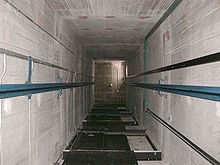Elevator surfing
This article needs additional citations for verification. (August 2020) |

Elevator surfing, also known as "lift surfing", "vator surfing" or "elevaroping", is an activity involving riding on top of elevators. Rarely, the activity may also involve jumping between moving elevators,[1] although most elevator surfers consider this to be unwise and needlessly dangerous.[citation needed]
Elevator surfing is illegal in many locations, and several people have died or were injured.[2] Surfers can be crushed between the elevator and the top or sides of the elevator shaft, be struck by the counterweight, or slip and fall to their deaths. In 1997 a person died when they were riding on the top of a lift and then at one point they fell from it 8 floors to the foot of the lift shaft below.[3] The surfer does have the ability to stop the elevator at any time by pressing the emergency stop button on the roof of the elevator car, decreasing the risk of being crushed against the top of the shaft.
Elevator surfing typically occurs in skyscrapers or on college campuses, especially those with tall buildings. Most large buildings have groups of elevators close together, which are most commonly used.
To begin, participants will usually go into such a building early in the morning, before too many people arrive to use the elevators, or late at night when most of the building's occupants have left. Entry into the elevator shaft is usually achieved by using a special key to open the outer doors or, if the key cannot be accessed, by lock picking. Alternatively, participants may force the elevator car's doors open between floors and unlatch the outer doors from the inside.[4] A common misconception is that the emergency hatch in the roof of the elevator can be opened from inside of the elevator car. However, this is rarely the case, and these are designed for the use of emergency crews to rescue trapped passengers.
This activity typically takes place when there is not much movement with the elevators, which lowers the risk and involvement. Accomplices will sometimes press buttons on the inside of the elevators to provide movement. Movement can also be provided using service controls located on top of the elevator car, which allow complete control over the movement of the elevator, but at a reduced speed.
There is also an activity called counterweight-surfing wherein the persons riding on top of the lift instead gets their friend to use the service controls to send the counterweight up and down that they are standing on.
References[]
- ^ Kruszelnicki, Karl. "Surfing Medical Madness". ABC. Retrieved 2006-08-27.
- ^ Kohr, RM (March 1992). "Elevator surfing: a deadly new form of joyriding". Journal of Forensic Sciences. 37 (2): 640–5. ISSN 0022-1198. PMID 1500904.
- ^ Mellor, James (30 May 1997). "Boy dies after falling eight floors in 'lift-surfing' craze". The Independent. Retrieved 6 October 2020.
- ^ Greger, Gene (2003-10-05). "Urban Exploring Techniques: Elevator Surfing". Retrieved 2006-08-27.
- Elevators
- Urban exploration